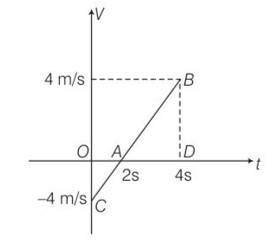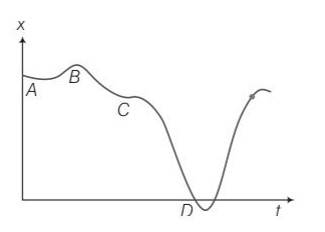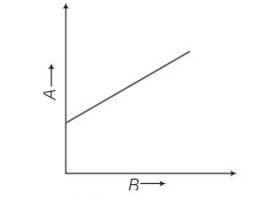Physics NCERT Exemplar Solutions Class 11th Chapter Three
Get insights from 30 questions on Physics NCERT Exemplar Solutions Class 11th Chapter Three, answered by students, alumni, and experts. You may also ask and answer any question you like about Physics NCERT Exemplar Solutions Class 11th Chapter Three
Follow Ask QuestionQuestions
Discussions
Active Users
Followers
New answer posted
5 months agoContributor-Level 10
This is a multiple choice answer as classified in NCERT Exemplar
(b, c, d) velocity of ball before collision =10+1=11m/s
Speed after collision= 10-1=9m/s
As the speed is changing after travelling 10 m and speed is 1m/s hence, time duration of the changing speed is 10
Since the collision of the ball is perfectly elastic there is no dissipation of energy hence, total momentum and kinetic energy are conserved.
Since the train is moving with constant velocity hence, it will act as inertial frame of reference as that of earth and acceleration will be same in both cases.
As the collision is perfectly elastic so momentum and total energy (K.E and
New answer posted
5 months agoContributor-Level 10
This is a multiple choice answer as classified in NCERT Exemplar
(a, c) as we know restoring force is F=-kx
Potential energy of the spring = 1/2kx2
The restoring force is central hence, when particle released it will execute SHM about equilibrium position
Also acceleration= f/m=-kx/m
But at equilibrium position when x=o, a also 0 and at equilibrium position potential energy converted into kinetic energy so speed will also maximum that time.
New answer posted
5 months agoContributor-Level 10
This is a multiple choice answer as classified in NCERT Exemplar
(a, d) x= t-sint
Velocity v = dx/dt=
d/dt (t-sint)=
=1-cost
When cost =1, velocity v=0
Vmax=1-costmin = 1- (-1)=2
Vmin =1- (cost)max= 1-1=0
Hence v lies between 0 and 2
Acceleration a=dv/dt=-sint
When v=0 then cost =1
Vmax= 1- (-1)=2, Vmin=1-1=0
New answer posted
5 months agoContributor-Level 10
This is a multiple choice answer as classified in NCERT Exemplar
(a, c, d) at point A graph will parallel to time axis hence, v=dx/dt=0. As the starting point is A hence, we can say that the particle is starting from rest.
At C, the graph changes slope, hence velocity also changes. As graph at C is almost parallel to time axis hence, we can say that velocity vanishes.
Velocity is 0. So particle at rest that time. As slope of D will be greater than E . so velocity will be greater at D.
New answer posted
5 months agoContributor-Level 10
This is a multiple choice answer as classified in NCERT Exemplar
(a, c, d) when we are calculating velocity of a displacement time graph we have to take slope similarly we have to take slope of velocity time graph to calculate acceleration . when slope is constant motion will be uniform.
When we are representing motion by a graph it may be displacement time, velocity time or acceleration time. Hence B may represent time . for uniform motion velocity time graph should be a straight line parallel to time axis.
if Quantity B may represent time. Also Quantity A is displacement if motion is uniform. Quantity A is velocity if motion is uniform
New answer posted
5 months agoContributor-Level 10
This is a multiple choice answer as classified in NCERT Exemplar
(c) in this situation we have to find net velocity with respect to the earth that will be equal to velocity of the girl plus velocity of escalator.
Let displacement is L the
Velocity of girl vg= L/t1
Velocity of escalator ve= L/t2
net velocity = velocity of escalator +velocity of girl
Vg=l/t1 and Ve=l/t2
So net velocity = L/t1+ L/t2
So t=
New answer posted
5 months agoContributor-Level 10
This is a multiple choice answer as classified in NCERT Exemplar
(b) x = (t-2)2
V= dx/dt= 2 (t-2)
And acceleration a = 2

When t =0 v= -4m/s
When t= 2s v= 0m/s
When t= 4s v= 4m/s
Distance travelled = area of graph =area of OAC+area of ABD= =8m
New answer posted
5 months agoContributor-Level 10
This is a multiple choice answer as classified in NCERT Exemplar
(c) Time taken to travel first half distance t1=
Time taken to travel second half distance t2=
Total time =t1+t2
formula for average velocity will be =
formula for average velocity will be= vav=average speed= total distance/total time =
New answer posted
5 months agoContributor-Level 10
This is a multiple choice answer as classified in NCERT Exemplar
(b) For maximum and minimum displacement we have to keep in mind the magnitude and direction of maximum velocity.
As maximum velocity in positive direction is vo maximum velocity in opposite direction is also vo.
Maximum displacement in one direction = voT
Maximum displacement in opposite direction=-voT
Hence -voT
New answer posted
5 months agoContributor-Level 10
This is a multiple choice answer as classified in NCERT Exemplar
(a) As the lift when coming downward directions displacement will be negative. We have to see whether the motion is accelerating or retarding.
We know that due to downward motion displacement will be negative, when the lift reaches 4th floor is about to stop hence motion is retarding in nature.
As displacement is in negative direction . velocity will also be negative i.e v<0
Taking an Exam? Selecting a College?
Get authentic answers from experts, students and alumni that you won't find anywhere else
Sign Up on ShikshaOn Shiksha, get access to
- 65k Colleges
- 1.2k Exams
- 679k Reviews
- 1800k Answers


